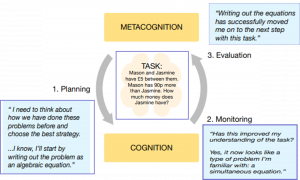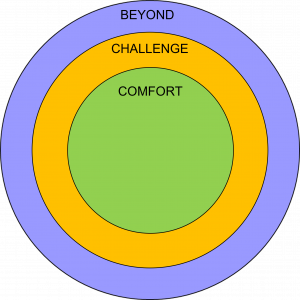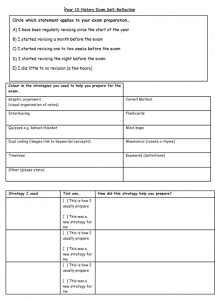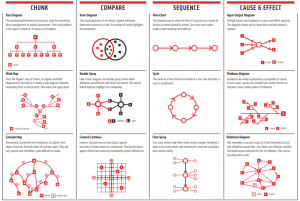Metacognition is a set of behaviours which maximise the potential for and efficacy of learning.
A metacognitive learner is one who has control over their cognitive skills and processes and understands how learning happens. They are able to apply this understanding to help them learn more effectively. This then aids their lifelong learning skills.
There are 3 strands of metacognition:
- Metacognitive knowledge – Pupils’ knowledge about the learning strategies they know will help them to complete the task.
- Metacognitive regulation – Pupils’ ability to plan, monitor and evaluate their own learning whilst completing a task.
- Metacognitive motivation – The extent to which the learner wants to perform a task.
Some strategies to aid metacognitive processes are outlined below:
(Handout summarising all strategies – Metacognition_Handout)
1.Plan, Monitor, Evaluate
This strategy works where pupils plan a strategy, monitor their performance during the task, and then evaluate the strategy’s success. This works in a cycle, and pupils are then able to apply their evaluation to the planning of their next task, as illustrated in this graphic from the EEF.

Here are some examples of this strategy in action (Plan monitor Evaluate)
2.Modelling and Metacognitive Talk
Modelling our thought processes aloud is an essential metacognitive strategy. Alex Quigley states it “reveals the thought processes of an expert learner” revealing why we have chosen the strategies we have, monitoring their success and evaluating them as we go.
The I do, We do, You do model can really help. Firstly, start by explicitly modelling our metacognitive processes for pupils. Secondly partially model, but invite contributions from pupils and prompt them to bring their metacognitive knowledge with them. You can also use talk partners/critical buddies to support this stage of the process. Thirdly, ask pupils to independently review the strategies/processes they have used.
Metacognitive talk: Vygotsky viewed speech and social interaction as playing a fundamental role in the learning process. He argued that a critical part of the learning process is social interaction between a pupil and a teacher, and that learners should gradually move away from the need for social guidance towards independence.
We can apply this to metacognition – in the classroom, promoting this independence from guided to independent talk by beginning with external talk, moving to private talk and eventually to internal talk.
- During external talk pupils’ actions are directed by an external agent, such as a teacher or a peer. The teacher will give prompts or will use talking partners.
- During private or silent talk pupils will internalise the prompts of the external agent and speak out loud to themselves. Pupils could model their own self-talk process outloud, or record themselves as a homework.
- During internal talk pupils’ self-talk becomes silent and internal. At this point, they are apply to apply metacognitive principles independently.
Here are some examples of these strategies in action (modelling_metacognitive talk)
3.Challenge Zones
Learning is more effective when pupils experience struggle in a positive way. If the brain finds something difficult or encounters failure, it grants it personal significance and is more likely to move to long term memory. A metacognitive learner should be able to identify how the work feels and can identify when something is not pitched appropriately for them.
The challenge zones is a tool used to get pupils to reflect on various tasks or strategies you might give them, and ask them to identify how challenging they find each one. The ‘challenge zone’ diagram helps with this.

Pupils are given a list of common activities/ strategies/ processes which are regularly set in lessons. They place them in the appropriate circle (comfort – easy, sometimes boring, very comfortable but won’t stretch me as a learner; challenge – ‘goldilocks’ zone – healthy struggle but will bring results; beyond zone – pitched too high or evoke a negative reaction, anxious or lack of confidence). Pupils then annotate the comfort and beyond zones, explaining why they feel that way.
The final stage in this model would be to then take this work and expand on how these tasks/ skills might be moved into the challenge zone. For example ‘reading challenging new texts out loud’ – what could the child do differently?
Here is an example of this in action with suggested reflection questions. (Challenge_zones)
4.Exam Wrappers
Exam wrappers encourage pupils to critically evaluate their own learning. It is focused on the activities they use to revise not the content. They can be used before and after summative assessments, to enable children to reflect on their learning and any mistakes. They must be used regularly in order to become embedded in their practice, and therefore more effective.

Here are some other examples (Exam wrappers)
5.Graphic Organisers
Graphic organisers can help pupils organise new information, make links to existing information and therefore encode/ embed information into long term memory. We can expose pupils to these tool by giving them the templates in lessons, modelling how to do this at first. We should then use metacognitive strategies to help them do this independently. Over time we hope that the children start to use these independently.
A metacognitive learner should then be able to identify which style of graphic organiser would be the most effective for which task, by planning, monitoring and evaluating.
 Here are some examples of Graphic Organisers being used (Graphic Organiser)
Here are some examples of Graphic Organisers being used (Graphic Organiser)